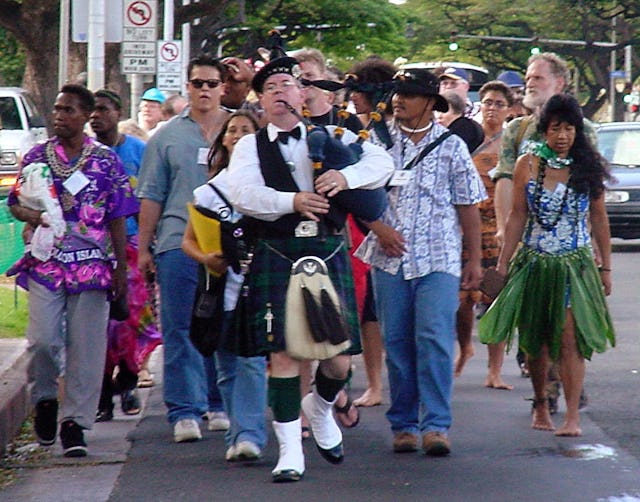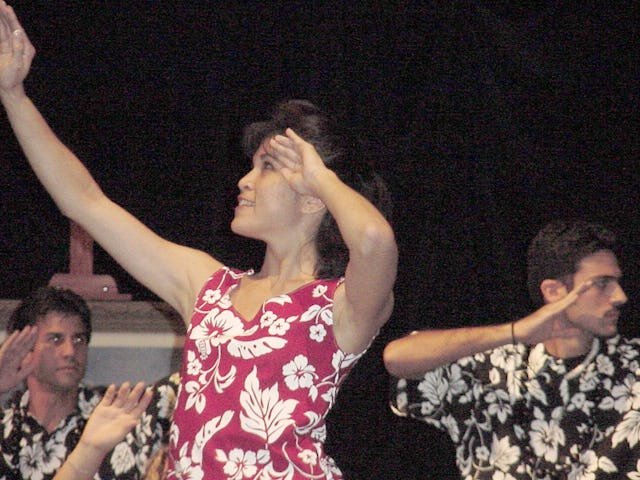'Fire in the Pacific' conference marks 100th anniversary of the Baha'i Faith in Hawaii
HONOLULU, HAWAII, United States — More than 1,000 Baha'is from at least 53 nations joined with the Baha'is of the Hawaiian Islands in December for a four-day celebration of the centennial of the establishment of the Baha'i Faith in Hawaii.
Titled "Fire in the Pacific," the conference featured music, dance performances, workshops and speeches that commemorated the history of the Faith in Hawaii -- and looked ahead to its future here and in the Pacific region.
Among other things, conference sessions focused on social issues of concern to the region, including moral and spiritual education for youth and children, the potential contribution of indigenous peoples to world civilization, the use of drama and the arts for positive social change, and diversity training.
The 20-23 December 2001 event received extensive media coverage and was attended by a number of prominent people. Princess Tooa Tosi Malietoa of Samoa extended greetings at the opening session on behalf of her father, His Highness Susuga Malietoa Tanumafili II, the head of state of the independent nation of Samoa. Ka'ulu Kukui Thomas, retired Hawaii State Court Judge and trustee for the Queen Liliuokalani Trust, welcomed the participants on behalf of the Hawaiian people. And Honolulu Mayor Jeremy Harris greeted conference attendees during a plenary session on Saturday morning.
"A highlight of the gathering was the permeation of all events with a spirit reflecting the cultures of the entire Pacific region," said Chris Cholas, Secretary of the National Spiritual Assembly of the Hawaiian Islands, the governing council for the Baha'i community in Hawaii. "There was a great prominence given to indigenous speakers and artists. There were representatives and performers not only from Hawaii but also from the Polynesian, Melanesian and Micronesian peoples. And many attendees remarked that this great display of diversity and respect for different cultures created a powerful spirit of joy and unity."
Among the highlights of the conference was a parade on 20 December, by some 600 participants, to the resting place of Agnes Baldwin Alexander, who was the first to bring word of the Baha'i Faith to the Hawaiian Islands -- and, indeed, the entire Pacific region -- in December 1901. Born in Hawaii, the granddaughter of missionaries, Ms Alexander first heard about the Baha'i Faith while on a trip to Europe. Returning to her native Hawaii on 26 December 1901, she devoted the rest of her life to spreading the teachings of Baha'u'llah in the Pacific and later in Japan.
For Emily Chew, a Baha'i from Australia, visiting the resting-place of Ms. Alexander "felt right because it showed respect" to those who first brought the Faith to the region. "It was a humble but wonderful way to begin this historic conference." Honolulu's top-rated television station KHON gave extensive coverage to the parade, which proved to be a showcase of humanity's diversity.
The conference featured more than 80 workshops, lectures, and performances. Attendees could choose from sessions on topics ranging from a presentation on the successes of a Baha'i vocational schools in Kiribati to discussions on how to better use consultation, a non-adversarial form of decision-making, in Baha'i community life.
There were also numerous presentations by Baha'i artists. Musician and Grammy Award winner K.C. Porter and other local Baha'is "jammed" in one of the smaller conference rooms; Australian actor Philip Hinton presented Portals to Freedom, the story of Howard Colby Ives; and Nadema Agard, a community service outreach specialist of the Smithsonian National Museum of the American Indian, presented a workshop on the sacred feminine presence in the arts of Native Americans.
In plenary sessions, the focus was largely on how the Baha'i teachings -- such as the equality of women and men and the recognition of humanity's essential oneness -- can be used to benefit communities in the Pacific region.
In a session on 21 December, for example, Dr. Sirus Naraqi, Professor of Medicine and Associate Dean, Western Clinical School, University of Sydney, spoke about the Baha'i writings concerning the Pacific and the similarities between the Teachings of Baha'u'llah and traditional beliefs of the Pacific Islanders. These similarities can easily be used to promote unity and cooperation, he said.
On Sunday, 23 December, the conference sponsored a traditional outdoor Ho'olaule'a, or festival, at the McCoy Pavilion in Ala Moana Beach Park. The Ho'olaule'a featured top local entertainers Amy Hanaiali'i, Hapa's Barry Flanagan, Martin Pahinui, Sean Na'auao and Ernie Cruz, as well as Mr. Porter, a performer on and the producer of Santana's Grammy Award Winning album "Supernatural." The event also featured entertainment by dancers from other Pacific Islands, along with arts, crafts and food booths, and Hawaiian plate lunches.
Attendees came from throughout Hawaii, the Pacific region, the United States, Canada, Alaska, Europe, Asia, Latin America, and Africa for the conference.

